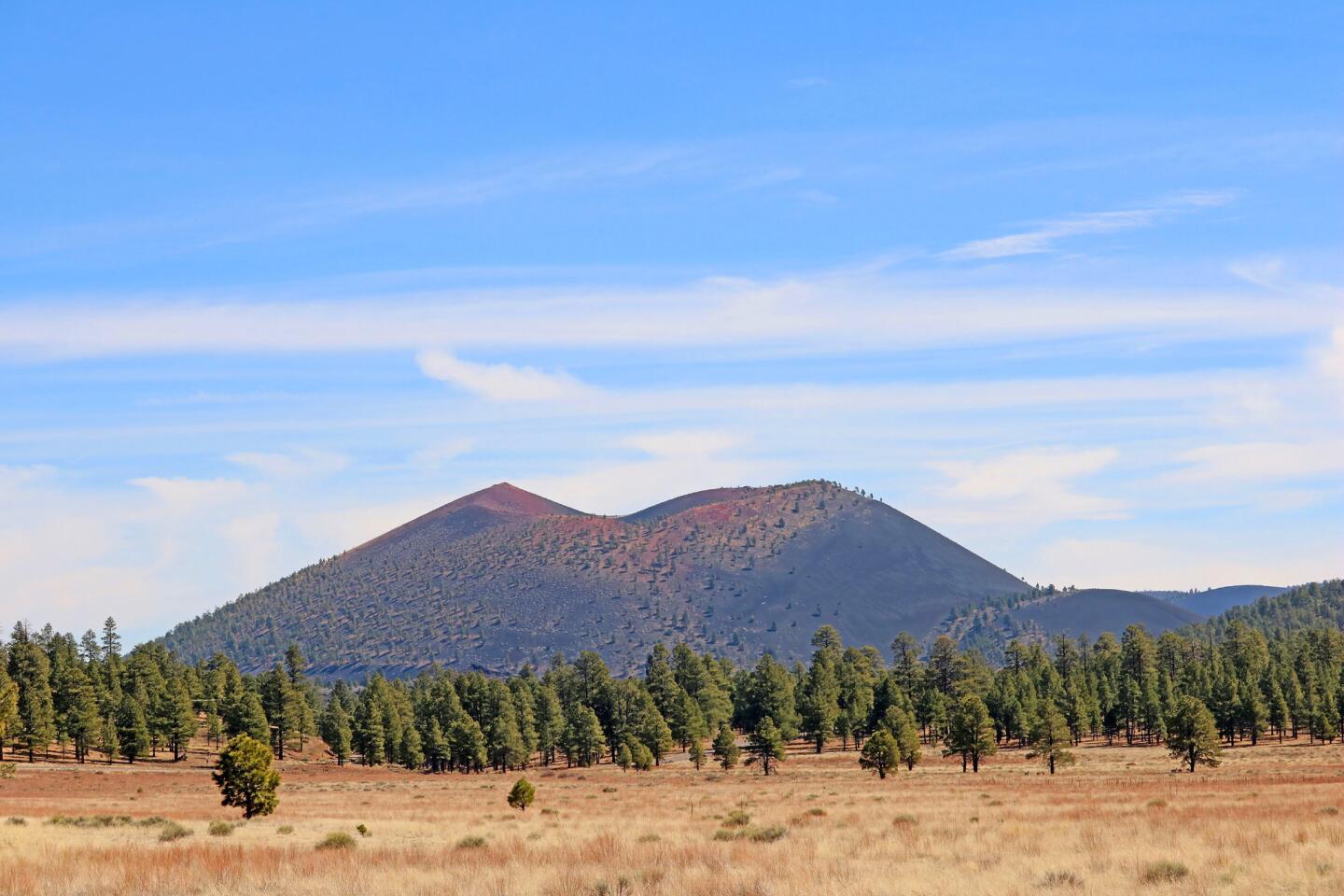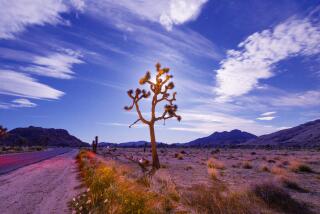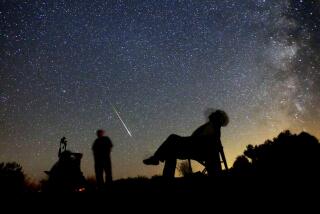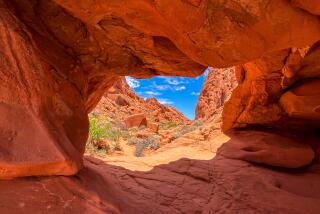A look at Flagstaff, Arizona, where Apollo 11 astronauts trained before landing on the moon
Reporting from Flagstaff, Ariz. â Before Neil Armstrong made that giant leap with a walk on the moon 49 years ago, he and other Apollo astronauts took smaller steps for mankind, training for the lunar landing in Flagstaff, Ariz.
The areaâs otherworldly geography stood in for the âmagnificent desolationâ of the moonâs surface: The three Apollo 11 astronauts â Armstrong, Buzz Aldrin and Michael Collins â completed critical training here before the moonwalk on July 20, 1969.
To honor that local history and the lunar landingâs 50th anniversary next year, Flagstaff is planning a yearlong celebration, kicking off with a launch party July 20 at the Orpheum Theater.
Activities will include presentations by historians, vintage film clips and demonstrations by scientists about the moon, lunar mapping and Apollo astronaut training in Flagstaff in the years leading to the launch.
Other lunar legacy events this summer will include an exhibition of a lunar rover prototype, Grover the Rover at the local Astrogeology Science Center, tours at nearby Meteor Crater and telescope viewings and exhibits at Lowell Observatory, as well as concerts, lectures and space-themed movies and menus at Flagstaffâs local restaurants.
Lunar training
A wave of astronauts that included Armstrong, Frank Borman, Pete Conrad, Jim Lovell, John Young, James McDivitt, Elliot See, Edward White and Thomas Stafford began training here in 1963, exploring the terrain of the Meteor and Sunset craters. They peered through telescopes and studied Lowellâs maps of the moonâs surface to begin preparation for an eventual lunar landing.
In the years leading to the Apollo 11 mission these astronauts, soon joined by Aldrin, Collins and others, conducted critical training below Flagstaffâs San Francisco Peaks. They tested spacesuits and flying equipment, perfected their lunar rover driving skills in local meteor craters and practiced lunar landings on the black volcanic fields of nearby Cinder Lake.
âThe coolest thing,â said Kevin Schindler, Lowell Observatoryâs historian and author of the book âNorthern Arizona Space Training,â âis that these superstar astronauts that were supposed to save us from the Russian menace were training right here in our backyard at places where you can still go and visit today.â
For me, getting this behind-the-scenes look at space training landmarks was a worthwhile addition to our familyâs day hike along the South Rim of the Grand Canyon and a good chance to spark an interest in space exploration in our school-age sons.
Lowell Observatory, which sits on a hill overlooking Flagstaffâs beautiful turn-of-the-century downtown, was an important first stop on our space history detour. It has been a draw for tourists since its founding in 1894, and it was high on our familyâs list.
Schindler gave us a guided tour, telling us about the observatoryâs long history of research, starting with the first evidence of the expanding universe in 1912 and the discovery of Pluto in 1930.
After dark, we walked to a small telescope that yielded a detailed view of the craters on the moonâs surface. At the observatoryâs domed Clark Telescope, we looked into the same eyepiece astronauts used to study the moon and scientists used to generate the beautiful, airbrushed maps of the lunar surface used by astronauts before they landed in the Sea of Tranquillity.
I wished we had brought a picnic dinner, so we could have stayed longer and seen a different planet or star cluster when scientists moved several of the telescopesâ positions later that evening. Instead, we headed for a late dinner downtown before driving the next morning to the Grand Canyon, an hour and a half away.
Retracing astronautsâ steps
The assembled astronauts, who were test pilots and not scientists, in 1964 hiked to the bottom of the Grand Canyon, where they collected rocks and studied its colorful limestone strata, Schindler said, in order to learn geology and get inspired for gathering samples on the lunar surface.
They also practiced using aerial photographs as topographical maps to navigate the canyonâs terrain.
A lengthy hike along the South Rim was enough for us, allowing us to tour the Pueblo architecture of Mary Colterâs Desert View Watchtower and appreciate from above the breathtaking trek the astronauts took in their training.
The timing was ideal, allowing us to make it to the historic El Tovar hotel just before sunset to relax and have a nice dinner.
If you want to follow the astronautsâ path down the canyon, go down the South Kaibab Trail, stay overnight at the Colter-designed Phantom Ranch before hiking halfway back up, then ride the mules on Bright Angel Trail.
More space training spots near Flagstaff
On another day we discovered three more interesting space training stops that are closer to Flagstaff.
The giant Meteor Crater, the worldâs best-preserved ancient meteorite impact site, is 45 minutes east of Flagstaff by way of Interstate 40. The crater, nearly a mile across and more than 550 feet deep, is so large that a 60-story building could stand on its floor, its top even with the rim.
Gear was tested here, including the astronautsâ first-generation space suits. They ripped on the rocks, forcing a redesign. You can enjoy the view from several lookouts or take a guided walk along the crater rim to learn more about its history and to see a display on astronaut training. A special lecture about the training is scheduled for October.
The black volcanic fields at Cinder Lake, half an hour east of Flagstaff, were blown up by the U.S. Geological Survey in the 1960s to re-create in 1:1 scale the exact site of Apollo 11âs projected lunar landing.
One part of the crater field has eroded, but a fenced-off section is fairly well preserved and still has a platform where the prototype lunar module was parked, Schindler said, making it worth a look.
Locals recommend accessing the area on Forest Service Road 776, marked as Cinder Hills ORV area on a sign on U.S. 89 just south of the turnoff for Sunset Crater Volcano National Monument.
Sunset Crater contains the namesake extinct volcano that created the cinder fields. Astronauts used the jagged, rocky terrain of Bonito Lava Flow, behind the visitor center, to test space suits, rover prototypes, gear and instruments.
Although no traces of space training remain in the park, itâs easy to see how this desolate landscape made a good lunar stand-in. The one-mile Lava Flow Trail loops around dramatic formations at the base of Sunset Crater. (Climbing to the top is no longer allowed.)
Farther east Cinder Hills Overlook gives you a good view of other volcanic summits, including Double, Haywire and Stewart craters.
On our last day, we spent a quiet afternoon exploring the shops and restaurants in Flagstaff, too tired to cross anything more off our list. But we left satisfied, having experienced the Grand Canyon and getting an insiderâs view of Apolloâs daring â and yet to be duplicated â feat in space.
Flagstaff Lunar Legacy Events
Below is a partial list of events and happenings planned to commemorate the 50th anniversary of the lunar landing. For updated information, go to Flagstaff Lunar Legacy or check each organizationâs website.
Lunar Legacy Launch: guest speakers, activities for kids, historic videos and tribute concert.
When: 5 p.m. July 20
Info: Orpheum Theater, 15 W. Aspen Ave., Flagstaff; (928) 556-1580. Free.
Lunar Legacy Exhibit: Lunar mapping and astronaut training at Lowell Observatory in the 1960s. Also at Lowell: Online Moon Mapping exhibit.
When: Lunar Legacy through July 2019; Moon Mapping through December 2020.
Info: Lowell Observatory, 1400 W. Mars Hill Road, Flagstaff; (928) 233-3211. Free with admission.
Kevin Schindler and Bill Sheehan will speak and sign copies of their book âNorthern Arizona Space Trainingâ at Lowell Observatory. Call (928) 233-3211 for details.
Lunar Lecture Series: Flagstaff Festival of Science series offers insights into the impact of the Apollo missions, Flagstaffâs role in supporting the pioneering endeavors and continuing space research in Arizona.
When: The second Wednesday of each month starting Aug. 8
Info: Coconino Community College, Lone Tree campus, Flagstaff.
Photography Exhibit: Astronaut training as well as historic and modern moon research in northern Arizona.
When: November-September 2019
Info: Cline Library, Northern Arizona University, 1001 S. Knoles Drive; Flagstaff; (928) 523-2173
Photography Exhibit: Historic images of astronaut training and other efforts supporting moon missions.
Info: Flagstaff Pulliam Airport, 6200 S. Pulliam Drive, Flagstaff; (928) 556-1234
USGS Photography Exhibit, Images from the U.S. Geological Surveyâs Astrogeology Science Center, Flagstaff.
When: July 1, 2019
Info: Museum of Northern Arizona, 3101 N. Fort Valley Road, Flagstaff; (928) 774-5211, musnaz.org
David Kring will describe Apollo-era astronaut training at Meteor Crater.
When: Oct. 4
Info: Meteor Crater Visitors Center, Winslow, Ariz.; (800) 289-5898
Cinder Lake Crater Field 1: Hike the simulated crater field created by explosives and used for astronaut training and instrument testing.
Info: fs.usda.gov/coconino.
If you go
THE BEST WAY TO FLAGSTAFF, ARIZ.
From LAX, American offer nonstop service to Flagstaff on Saturdays. American, Alaska and United offer connecting service (change of planes). Restricted round-trip fares from $342, including taxes and fees.
Flagstaff is a seven-hour-drive from Los Angeles.
WHERE TO STAY
Little America Hotel, 2515 E. Butler Ave.; (928) 779-7900. This 240-room resort is set on 500 pine-covered acres just outside downtown. Pool and restaurant. Standard room from $229.
Weatherford Hotel, 23 N. Leroux St.; (928) 779-1919. Centrally located turn-of-the-century property with a lovely wrap-around balcony and popular pub and grill. Standard rooms from $115.
Hotel Monte Vista, 100 N San Francisco St.; (928)-779-6971. This lively Prohibition-era downtown hotel has a colorful past, live music, and many believe it to be haunted. Queen rooms from $125.
WHERE TO EAT
MartAnneâs Breakfast Palace, 112 Historic Route 66; (928) 773-4701. Tasty Mexican-style breakfasts, hot chocolate and colorful decor.
Lumberyard Brewing Co., 5 S. San Francisco St.; (928) 779-2739. Family-friendly microbrewery and restaurant built in an old lumberyard by the train station. Vegetarian options.
The Cottage, 126 W. Cottage Ave; (928) 774-8431. Fine-dining restaurant serves French farmhouse cuisine in a quaint bungalow in the Southside Historic District. Closed Mondays and Tuesdays.
More to Read
Sign up for The Wild
Weâll help you find the best places to hike, bike and run, as well as the perfect silent spots for meditation and yoga.
You may occasionally receive promotional content from the Los Angeles Times.







